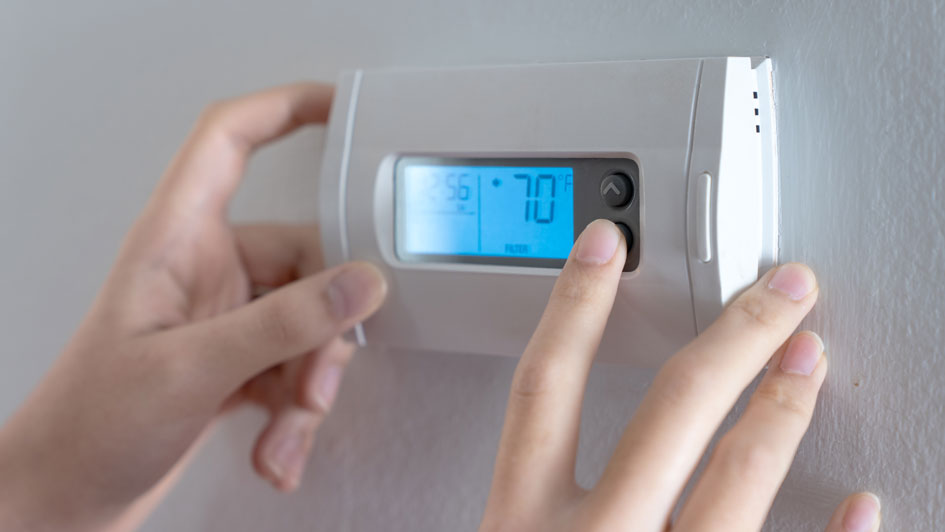
We all like saving money on our monthly utility bills, but it turns out there’s a way to do it when you aren’t even home.
It starts with your thermostat. By learning more about its special features and settings, you can help the thermostat plan for your preferred temperatures. This means establishing various temperature settings for when you’re at home, away or even when you’re asleep.
With a few simple adjustments, you have more time to enjoy pleasant temperatures while keeping more money in your pocket. Check out our guide on how your thermostat can be a source of energy savings:
While at Home
Pretty much whenever you're home, you want to enjoy a comfortable temperature. That’s why it’s best to set your thermostat lower in the summer while you are in the house to appreciate the cool air.
But the ideal temperature for when you're in your home during the summer is usually between 78 and 80 degrees Fahrenheit. With this adjustment, you'll avoid the worst of summer while keeping your energy bill more manageable.
While Away
If you're setting the temperature for a vacation or other trip away from the house, it's extremely common to move the thermostat higher than you would if you were in the house.
Depending on the local climate or your home's location, you can set the thermostat to temperatures as high as 88 degrees while no one is home before you adjust it back to the sweet spot of 78-80 degrees after you return. This way, your air conditioning won't have to work constantly to provide cooling for a bunch of empty rooms.
While Asleep
To enjoy a good night's sleep during the summer, you want a temperature that's nice and cool. A good rule of thumb is between 68-72 degrees Fahrenheit. You won't have to worry about getting too hot or too cold at some point overnight.
Other Ways to Use Less Energy:
- Install a smart thermostat: Switching to a smart thermostat in the summer helps save money on energy costs since it can plan your temperature adjustments according to your lifestyle and home environment. It'll take care of making changes while you are home or sleeping, while allowing it to warm up when no one is home. With models like the Lennox iComfort, you are able to adjust settings and schedules through your smartphone, tablet or laptop. Scheduling smart thermostat installation in your Newton home is an effortless way to set the correct temperature whether you're at home or across the country.
- Update your existing HVAC system: Upgrading your HVAC system is another great option for long-term energy savings. By investing in a more energy-efficient system, you can also count on lower utility bills since more efficient equipment requires less energy to reach your preferred temperatures. Air conditioning installation in Newton is only a phone call away, so don't hesitate to reach out to local pros like Brookwood Inc who can set you up for success.
- Stay on top of routine AC maintenance: Investing in or ignoring regular air conditioning maintenance in Newton can have a serious effect on your total monthly energy use. With regular cleaning of the coils, checking for damage and clearing ventilation of dust and debris, you may notice your HVAC system run more efficiently. More efficient operation reduces strain on the unit and lowers operational costs, leading to lower energy usage, which translates into lower energy bills.
- Clean or replace the air filter on a regular basis: Regularly changing the air filters in your HVAC system saves money by improving airflow. When filters are clogged with dirt and debris, an AC unit has to work harder, and the strain can reduce the system’s life span and result in breakdowns.
- Verify your attic has enough insulation: Insulation is a crucial component for any energy-efficient home, keeping the hot air outside and the cool air inside through summer. The North American Insulation Manufacturers Association (NAIMA) offers an official recommendation stating homeowners in souther states should install at least 13-14 inches of insulation, while those in northern U.S. states should have 16-18 inches.
- Review your air ducts: A leak in the air ducts could increase your energy bills much more than 20 percent, plus it can potentially allow harmful emissions from your water heater, clothes dryer and other appliances to get into the atmosphere of your home. Watching for signs of leaks and sealing them can address both concerns.
- Seal all other leaky spots in your home: Finding and sealing any remaining leaks in your home with caulk, foam sealant or weather-stripping keeps temperatures a little cooler on hot summer days. Don't forget to check for any gaps around windows, doors and even outdoor fixtures. Devoting time and effort to sealing leaks now can help you save a lot in the long run.


